بواسطة شبكة عملاقة فوق سفينة كانت سبيس اكس تطمح الى استعادة مخروط مقدمة الصاروخ المقاوم للحرارة. الامر مشابهة للعبة التنس لكنها لم تضبط هذه المرة.
SpaceX tried to catch its rocket’s nose cone with a giant net — and just missed

After launching its Falcon 9 rocket from California this morning, SpaceX used a giant net to try to recover the rocket’s nose cone as it fell down in the Pacific Ocean. The first-time experiment failed, however: one of the pieces of the nose cone missed the net, which was attached to a ship, and landed intact on the sea surface instead.
Also known as the payload fairing, the nose cone is an earplug-shaped casing that sits on the top of the rocket, shielding the vehicle’s payload during launch. Once in space, the fairing breaks apart into two pieces and falls back to Earth. Normally, companies don’t recover the pieces of the fairing after a launch, but SpaceX CEO Elon Musk has been eager to find a way to save the hardware. “Imagine you had $6 million in cash in a palette flying through the air, and it’s going to smash into the ocean,” Musk said during a press conference in March 2017. “Would you try to recover that? Yes. Yes, you would.”
SpaceX has become famous for landing its rockets after launch so they can fly again. But the way SpaceX plans to recover its fairing is quite different from how it recovers its rockets. The Falcon 9 boosters essentially reignite their engines as they fall back to Earth, helping to control and slow their descent. A typical rocket fairing doesn’t have any onboard engines, however. So SpaceX has equipped its latest nose cone with a guidance system and thrusters, tiny engines that help guide the pieces through the atmosphere when they break away from the rocket.
Then, as the pieces descend, they deploy thin parachute-like structures known as parafoils to slow their fall. Down at the surface, a SpaceX boat named Mr. Steven (a random name, Musk said) attempts to catch one of the fairing pieces with a giant net attached to large claw-like appendages.
SpaceX has been able to land its fairings in the ocean before, but this was the first time the company deployed Mr. Steven to catch one of the pieces. Musk noted that a fairing half missed the boat by a few hundred meters. However, the company should be able to fix the problem by making the parafoils bigger, he said.
Though the pieces may have landed undamaged in the Pacific, it’s unclear if they can be used again. The possibility seems unlikely, as seawater can cause significant damage to spacecraft without proper shielding. In January, one of SpaceX’s Falcon 9 rockets somehow managed to survive intact after falling in the Atlantic Ocean, and Musk said the company would attempt to pull it back to shore. But that never happened. “The stage broke apart before we could complete an unplanned recovery effort for this mission,” SpaceX said in a statement.
Still, SpaceX will keep trying to save more nose cones in the months ahead. “My guess is next six months we’ve got fairing recovery figured out,” Musk said during a press conference for the Falcon Heavy launch. He even added that Mr. Steven could be used to catch more than just the fairing. “I think we can do the same thing with Dragon,” he said, referring to the company’s crew and cargo spacecraft.
